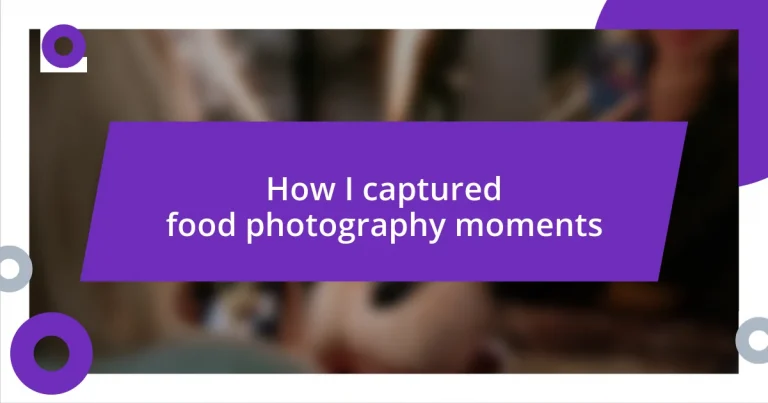Key takeaways:
- Understanding lighting, angles, and props are crucial for creating appealing food photos; soft natural light and simple backgrounds enhance the dish.
- Investing in quality equipment like a DSLR and macro lens, along with using tripods for stability, can significantly improve your food photography.
- Effective editing and sharing strategies, including telling stories behind your dishes and collaborating with others, elevate your images and engage your audience.

Understanding Food Photography Basics
When diving into food photography, understanding lighting is crucial. I remember my first attempt; I was so eager to capture the dish that I ignored the harsh overhead light. The result? The food looked flat and unappetizing. Have you ever felt disappointed by a photo that didn’t do your meal justice? Soft, natural light can transform a simple plate into a work of art.
Angles play a gigantic role in how we perceive food through the lens. During one of my shoots, I discovered that a 45-degree angle offered an enticing view, showcasing layers and textures beautifully. It’s like tasting food with your eyes! Why not experiment with different angles? You’ll find that each perspective tells a different story.
Props and backgrounds can either enhance or distract from your subject. Early on, I used too many cluttered backgrounds, which overshadowed the dish. I’ve learned that a simple, cohesive backdrop allows the food to shine. What do you prefer—minimalism or vibrant settings? Finding the right balance can elevate your photography from ordinary to extraordinary.

Choosing the Right Equipment
Choosing the right equipment is pivotal in food photography, and it can significantly influence the outcome of your shots. When I first started, I used my smartphone, which produced decent images, but I quickly realized that investing in a good camera made a world of difference. The depth of field I could achieve with my DSLR brought a dreamy quality to my food shots that I could never capture before. Have you ever noticed how much richer a taste feels when the presentation is just right?
Lenses are another critical aspect. Initially, I used the standard kit lens, but once I switched to a macro lens, I felt like I had opened up a new realm of possibilities. The ability to zoom in on intricate details, like dewdrops on a ripe tomato or the glaze on a pastry, allows you to tell a more compelling story through your images. Have you tried using different lenses in your photography journey? I found that experimenting with focal lengths not only improved my skills but also enhanced my creativity.
Tripods are often overlooked, yet they can dramatically improve your composition, especially in low-light situations. In one memorable shoot, after battling with shaky hands and blurry images, I decided to use a tripod. The stability it provided changed the game, allowing me to focus solely on framing and composition without worrying about camera shake. What tools do you find essential for your photography? I believe that the right equipment, combined with your unique perspective, can result in truly stunning images.
| Equipment | Key Features |
|---|---|
| DSLR | High-quality images, interchangeable lenses, better depth of field |
| Macro Lens | Detailed close-ups, enhances textures, versatile for various food types |
| Tripod | Stability in low-light, prevents shake, improves composition |

Setting Up for Food Shots
Setting up your shot is where the magic begins. I can still recall the time I spent hours rearranging dishes and props only to realize the composition felt off. I learned that a careful setup isn’t just about placement; it’s about creating a scene that tells a story. Each element should contribute to the overall vibe—after all, that instant connection with your audience begins right here.
Consider these essentials when arranging your food shots:
– Lighting: Aim for natural light where possible. It adds warmth and brings out the true colors of your dish.
– Composition: Think about the rule of thirds—placing your subject slightly off-center can create a more engaging image.
– Props: Choose utensils and backgrounds that complement, not compete with, your main dish.
– Color Palette: Stick to a cohesive color scheme to create harmony. A pop of contrasting color can be a great enhancement!
The final touches can elevate your food photography from good to breathtaking. I remember once adding a touch of fresh herbs scattered casually around a dish, and suddenly, the whole scene felt alive. Don’t underestimate the power of those little details; they add depth and personality. Setting up your frame is an art form that can be as expressive as cooking itself.
Some tips to keep in mind while setting up:
– Experiment with Layering: Use different heights and textures to add dimension.
– Clean Up Clutter: If a prop doesn’t serve a purpose, it’s best left out.
– Use Reflectors: I often use a simple white board to bounce light right back onto the food, enhancing its vibrance.
– Capture Different Stages: Document the preparation stages; it can help tell a richer story.
This meticulous effort in arranging your shots is what brings your culinary creations to life on camera. Each setup is a chance to convey a narrative, and I relish the moment just before I hit the shutter, knowing I’ve poured my passion into each frame.

Mastering Composition Techniques
Composition is like the unsung hero of food photography; it is what transforms a simple shot into a visual feast. I remember experimenting with different angles, eventually finding that a bird’s-eye view gave my dishes a stunning perspective. Have you ever noticed how the same meal can look completely different depending on the angle? I found that capturing my pasta from above not only showcased its vibrant look but also allowed the colors of the other ingredients to shine. It’s all about finding that sweet spot.
In my journey, understanding the rule of thirds became a game changer. I felt a subtle thrill when I began consciously placing my subject along those invisible lines, creating a sense of balance and movement. For instance, framing a glass of lemonade with a slice of lemon edging towards the corner not only drew the eye but made the image feel alive. Have you tried applying this technique? It might sound simple, but when I mastered it, my photos started resonating more with my viewers.
Another trick I’ve found invaluable is using leading lines. They guide the viewer’s gaze to the focal point of the image. I once placed a bowl of soup at the end of a beautifully set wooden table, allowing the grain of the table to lead the eye directly to the dish. It not only enhanced the composition but also had an inviting effect, as if I was beckoning the viewer to join me for dinner. Have you explored how you can use lines in your compositions? Each shot presents an opportunity to direct emotion and intrigue through thoughtful placement.

Lighting Tips for Food Photography
Lighting can truly make or break your food photographs. I’ve had moments where I shot in dim light, thinking I could salvage it with editing later, only to be disappointed by the lack of vibrancy. Natural light is my go-to; it gives food that inviting glow that makes it look almost irresistible. Have you experienced that warm, golden hour light? It casts a magical hue that enhances the textures and colors, transforming a simple plate into a masterpiece.
Reflectors are a simple yet game-changing tool in food photography. I vividly remember my first shoot with a white board I used as a reflector. Placing it opposite the window, I could almost see the food come to life as the light bounced back, illuminating the dish beautifully. Have you tried using a reflector? It’s fascinating how a little adjustment can enhance the richness of colors, making your food almost pop off the screen.
When you can’t rely on natural light, don’t shy away from experimenting with artificial sources. I once used a soft-box in a not-so-great space, and it helped create a cozy atmosphere around my dish. Instead of harsh overhead lighting, I angled the soft-box to create shadows that enhanced the dish’s dimension, adding an inviting touch. Light placement can tell a story; have you thought about what your light is saying? Every setup creates its own mood, allowing you to express the flavors and feelings behind your culinary endeavors.

Editing and Enhancing Food Images
Editing food images is where the magic often happens, turning good shots into tantalizing displays. After capturing a vibrant stir-fry, I once spent an afternoon adjusting brightness and contrast to elevate the vivid colors. Have you ever noticed how a small tweak can bring out the dish’s flavors in a photo, making it almost tasteable? I believe it’s about enhancing what’s already there, not overpowering it.
A consistent editing style can evoke a certain feel across your work, creating a recognizable brand. I remember when I started using presets; it felt like finding a secret ingredient. Each image seemed instantly more cohesive, almost as if they were telling a story together. Have you experimented with presets? They can save time and provide a polished look without the intricate fuss of detailed edits.
Sharpening your images can also make a significant difference, especially when highlighting textures. I recall the first time I applied a subtle sharpen to a cake photo, emphasizing the frosting’s swirls—it felt like the cake leaped off the screen! However, moderation is key; no one wants to bite into a pixelated treat. Have you ever pushed the sharpening too far? You learn with every shot that finding the right balance is as essential as the ingredients in your dish.

Sharing and Promoting Your Photos
Once you’ve captured those mouth-watering shots, sharing them becomes an exciting next step. I remember the thrill of posting my first food photo on social media and receiving immediate feedback. It felt like passing around a dish at a dinner party; everyone is eager to take a bite! Have you thought about which platforms best showcase your work? Platforms like Instagram and Pinterest are fantastic as they cater specifically to visuals, connecting you with fellow food enthusiasts who appreciate your culinary artistry.
Promoting your photos doesn’t end with a simple upload. Engage with your audience by sharing stories behind the dishes. For instance, when I posted a photo of a rustic apple tart, I included how it reminded me of cozy family gatherings during fall, evoking nostalgia. Have you tried telling a story with your images? It can transform a quick glance into an emotional connection, encouraging viewers to interact and share, amplifying your reach.
Consider collaborating with other food creators or influencers to expand your audience. I vividly recall teaming up with a local baker; our combined posts generated a buzz that neither of us expected! Sharing each other’s work not only builds community but also invites a fresh set of eyes to your photos. Have you thought about who you could collaborate with? Sometimes, a little teamwork can turn your passion into a delightful feast for a larger audience.














